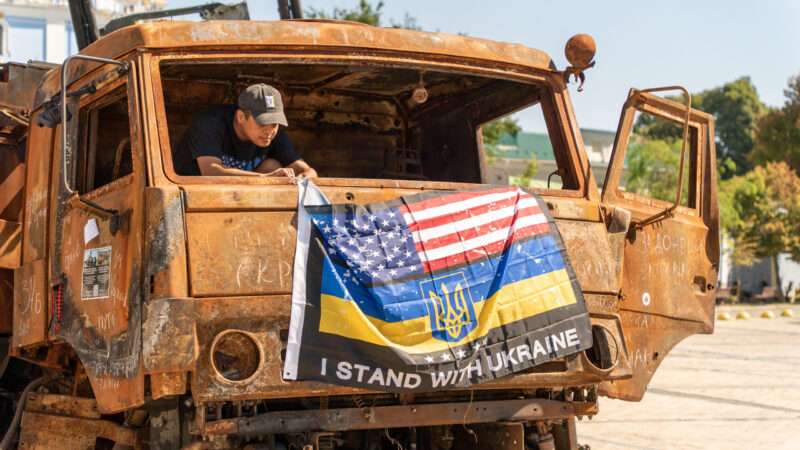
Russia’s invasion of Ukraine was expected to be quick. It would take a few weeks, maybe, or even mere days for forces from Moscow to sweep into Kyiv. But Ukraine’s dogged self-defense soon upset those expectations, and, nine months into the conflict, U.S. military and financial aid to Ukraine appears to be an open-ended commitment. Even with Russia retreating from Kherson City and other areas of Ukraine, American guns and money will keep flowing to the nation for the foreseeable future.
President Joe Biden has already put some limits on what that commitment will entail. “So long as the United States or our allies are not attacked,” he wrote in The New York Times this past summer, “we will not be directly engaged in this conflict, either by sending American troops to fight in Ukraine or by attacking Russian forces.” Biden also wrote that U.S. aims stop well short of ousting Russian President Vladimir Putin, “encouraging or enabling Ukraine to strike beyond its borders,” or “prolong[ing] the war just to inflict pain on Russia.”
Those constraints are welcome, but they aren’t enough to keep America from repeating foreign policy mistakes of the recent past. If the U.S.-Ukraine relationship is to continue as is, we need transparent documentation of how U.S. aid is used, a consistent effort to facilitate diplomacy, and serious consideration of when and why the U.S. role might have to change.
On the first count, we already have a model for the type of documentation needed. As Sen. Rand Paul (R–Ky.) proposed in May, American humanitarian and military aid to Ukraine should be supervised by an inspector general, much like the Special Inspector General for Afghanistan Reconstruction (SIGAR). The SIGAR office was formed in 2008 and tasked with auditing reconstruction work in Afghanistan by investigating allegations of waste, fraud, and abuse; and taking on ad hoc inspection projects as needed.
SIGAR work did not always lead to accountability—on the contrary, The Washington Post‘s Afghanistan Papers, published after a multiyear legal fight in 2019, revealed just how often “senior U.S. officials failed to tell the truth about the war in Afghanistan throughout the 18-year campaign, making rosy pronouncements they knew to be false and hiding unmistakable evidence the war had become unwinnable.” Still, those papers were SIGAR documents. SIGAR is the reason the Post was able to expose these deceptions. We need a similar record-keeper in Ukraine to document similar lies and fiascos.
Facilitating diplomacy between Kyiv and Moscow is a less straightforward task. Both Putin’s regime and Ukrainian President Volodymyr Zelenskyy have made clear their complete disinterest in negotiations. That disinterest will continue as long as each government can map a plausible path to military victory. We might justly wish for the Russian military in full retreat, even from Crimea, offering repentance and restitution and whatever else Ukraine demands, but it’s a wish unlikely to be granted.
Yet war conditions change, sometimes very suddenly, and either party may come to see the merits of a deal which secures peace, if not total triumph. Diplomacy isn’t wanted now, but one day, hopefully soon, it might be.
Washington should use its diplomatic infrastructure, influence, and communication with both sides to prepare for that moment. The Biden administration should urge Ukraine and Russia alike to “demonstrate openness to the prospect of eventual talks, and to moderate public expectations of a decisive victory,” as political scientists Samuel Charap and Miranda Priebe recently argued in Foreign Affairs. That includes emphasizing that “a negotiated settlement would not be an act of capitulation.” We can set the stage for talks before the players are ready to appear.
That preparation is closely linked to the third and most difficult project at hand, which is considering—at least internally, if not publicly—what would count as mission creep in this war. Are there strategic, geographic, or chronological boundaries we won’t cross? For example, if Russia uses a tactical nuclear weapon in Ukraine, is that a red line? If the SIGAR analogue exposes major fraud or failure, what happens? Or if Russia leaves all Ukrainian land but “contest[s] a Ukrainian victory for years to come,” perhaps via air war, as Charap and Priebe posit, does the U.S. posture remain unchanged?
In short: How will we keep Ukraine from becoming a forever proxy war and ensure an American president isn’t still signing quarterly aid packages for Kyiv in 2045? It seems we’re involved for the long haul, but surely we ought to be thinking about how long is long enough.
The post The U.S. Is Entangled in Ukraine for the Long Haul appeared first on Reason.com.
from Latest https://ift.tt/Q0ekBYy
via IFTTT